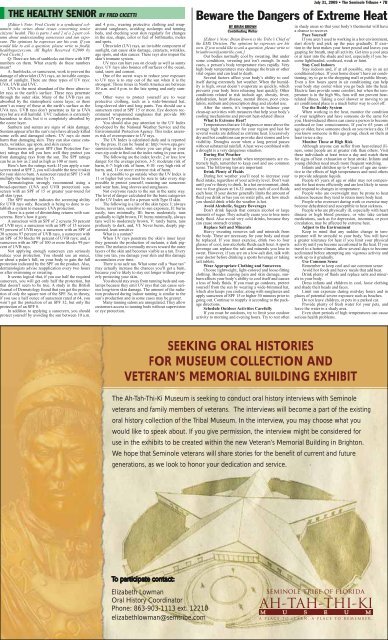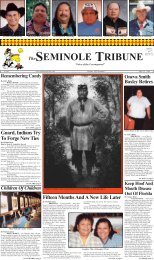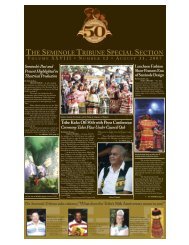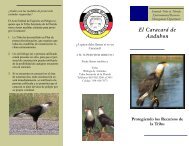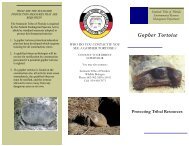Brittany Smith Crowned Miss Florida Seminole at 52nd Annual ...
Brittany Smith Crowned Miss Florida Seminole at 52nd Annual ...
Brittany Smith Crowned Miss Florida Seminole at 52nd Annual ...
- No tags were found...
You also want an ePaper? Increase the reach of your titles
YUMPU automatically turns print PDFs into web optimized ePapers that Google loves.
THE HEALTHY SENIOR BY FRED CICETTI[Editor’s Note: Fred Cicetti is a syndic<strong>at</strong>ed columnistwho writes about issues concerning seniorcitizens’ health. This is parts 1 and 2 of a 2-part columnabout understanding sunscreens and sun exposure.The opinions he expresses are his own. If youwould like to ask a question, please write to fred@healthygeezer.com. All Rights Reserved ©2009 byFred Cicetti.]Q: There are lots of sunblocks out there with SPFnumbers on them. Wh<strong>at</strong> exactly do these numbersmean?A: Sunblocks, or sunscreens, work to prevent thedamage of ultraviolet (UV) rays, an invisible componentof sunlight. There are three types of UV rays:UVA, UVB and UVC.UVA is the most abundant of the three ultravioletrays <strong>at</strong> the earth’s surface. These rays penetr<strong>at</strong>ethrough the outer skin. Many of the UVB rays areabsorbed by the str<strong>at</strong>ospheric ozone layer, so therearen’t as many of these <strong>at</strong> the earth’s surface as theUVA rays. UVB rays don’t penetr<strong>at</strong>e as far as UVArays but are still harmful. UVC radi<strong>at</strong>ion is extremelyhazardous to skin, but it is completely absorbed bythe ozone layer.Sunburn and suntan are signs of skin damage.Suntans appear after the sun’s rays have already killedsome cells and damaged others. UV rays do moreharm than damaging skin. They can also cause c<strong>at</strong>aracts,wrinkles, age spots, and skin cancer.Sunscreens are given SPF (Sun Protection Factor)r<strong>at</strong>ings th<strong>at</strong> tell you how well they protect youfrom damaging rays from the sun. The SPF r<strong>at</strong>ingscan be as low as 2 and as high as 100 or more.Here’s how the r<strong>at</strong>ings work: If you apply a sunscreenr<strong>at</strong>ed <strong>at</strong> SPF 2, you will double the time it takesfor your skin to burn. A sunscreen r<strong>at</strong>ed <strong>at</strong> SPF 15 willmultiply the burning time by 15.Derm<strong>at</strong>ologists strongly recommend using abroad-spectrum (UVA and UVB protection) sunscreenwith an SPF of 15 or gre<strong>at</strong>er year-round forall skin types.The SPF number indic<strong>at</strong>es the screening abilityfor UVB rays only. Research is being to done to establisha system to measure UVA protection.There is a point of diminishing returns with sunscreens.Here’s how it goes:A sunscreen with an SPF of 2 screens 50 percentof UVB rays; a sunscreen with an SPF of 15 screens93 percent of UVB rays; a sunscreen with an SPF of30 screens 97 percent of UVB rays, a sunscreen withan SPF of 50 blocks 98 percent of UVB rays; and, asunscreen with an SPF of 100 or more blocks 99 percentof UVB rays.Not applying enough sunscreen can seriouslyreduce your protection. You should use an ounce,or about a palm’s full, on your body to gain the fullprotection indic<strong>at</strong>ed by the SPF on the product. Also,derm<strong>at</strong>ologists advise reapplic<strong>at</strong>ion every two hoursor after swimming or swe<strong>at</strong>ing.It seems logical th<strong>at</strong>, if you use half the requiredsunscreen, you will get only half the protection, butth<strong>at</strong> doesn’t seem to be true. A study in the BritishJournal of Derm<strong>at</strong>ology found th<strong>at</strong> you get the protectionof only the square root of the SPF. So, in theory,if you use a half ounce of sunscreen r<strong>at</strong>ed <strong>at</strong> 64, youwon’t get the protection of an SPF 32, but only theprotection of an SPF 8.In addition to applying a sunscreen, you shouldprotect yourself by avoiding the sun between 10 a.m.and 4 p.m., wearing protective clothing and wraparoundsunglasses, avoiding sunlamps and tanningbeds, and checking your skin regularly for changesin the size, shape, color or feel of birthmarks, molesand spots.Ultraviolet (UV) rays, an invisible component ofsunlight, can cause skin damage, c<strong>at</strong>aracts, wrinkles,age spots, and skin cancer. These rays also impair theskin’s immune system.UV rays can hurt you on cloudy as well as sunnydays. UV rays also bounce off surfaces of the ocean,sand, snow and cement.One of the surest ways to reduce your exposureto UV rays is to stay out of the sun when it is thestrongest. Those times in North America are between10 a.m. and 4 p.m. in the l<strong>at</strong>e spring and early summer.Other ways to protect yourself are to wearprotective clothing, such as a wide-brimmed h<strong>at</strong>,long-sleeved shirt and long pants. You should use asunscreen r<strong>at</strong>ed <strong>at</strong> SPF 15 or more. Eye doctors recommendwraparound sunglasses th<strong>at</strong> provide 100percent UV ray protection.You should also pay <strong>at</strong>tention to the UV Indexdeveloped by the N<strong>at</strong>ional We<strong>at</strong>her Service and theEnvironmental Protection Agency. This index assessesrisk of overexposure to UV rays.The UV Index is calcul<strong>at</strong>ed daily and is reportedby the press. It can be found <strong>at</strong>: http://www.epa.gov/sunwise/uvindex.html, where you can plug in yourown zip code to find out the index r<strong>at</strong>ing in your area.The following are the index levels: 2 or less: lowdanger for the average person, 3-5: moder<strong>at</strong>e risk ofharm, 6-7: high risk of harm, 8-10: very high risk ofharm, and, 11 or more: extreme risk of harm.It is possible to go outside when the UV Index is11 or higher but you must be sure to take every steppossible to protect yourself, meaning use sunscreenand wear h<strong>at</strong>s, long sleeves and sunglasses.Not everyone reacts to the sun in the same way.The level of danger calcul<strong>at</strong>ed for the basic c<strong>at</strong>egoriesof the UV Index are for a person with Type II skin.The following is a list of the skin types: I: alwaysburns, never tans, sensitive to sun exposure, II: burnseasily, tans minimally, III: burns moder<strong>at</strong>ely, tansgradually to light brown, IV: burns minimally, alwaystans well to moder<strong>at</strong>ely brown, V: rarely burns, tansprofusely to dark, and, VI: Never burns, deeply pigmented,least sensitiveWh<strong>at</strong> is a suntan?When UV rays penetr<strong>at</strong>e the skin’s inner layerthey gener<strong>at</strong>e the production of melanin, a dark pigment.The melanin eventually moves toward the outerlayers of the skin and becomes visible as a tan. Everytime you tan, you damage your skin and this damageaccumul<strong>at</strong>es over time.There is no safe tan. Wh<strong>at</strong> some call a “base tan”may actually increase the chances you’ll get a burn,because you’re likely to stay out longer without properlyprotecting your skin.You should stay away from tanning beds and sunlampsbecause they emit UV rays th<strong>at</strong> can cause seriouslong-term skin damage. The amount of the radi<strong>at</strong>ionproduced during indoor tanning is similar to thesun’s production and in some cases may be gre<strong>at</strong>er.Many tanning salons are unregul<strong>at</strong>ed. They allowcustomers access to tanning beds without supervisionor eye protection.July 31, 2009 • The <strong>Seminole</strong> Tribune • 7BBeware the Dangers of Extreme He<strong>at</strong>BY BRIAN BROWNContributing Writer[Editor’s Note: Brian Brown is the Tribe’s Chief ofthe EMS Division. The opinions he expresses are hisown. If you would like to ask a question, please write tobrianbrown@semtribe.com.]Our bodies normally cool by swe<strong>at</strong>ing. But undersome conditions, swe<strong>at</strong>ing just isn’t enough. In suchcases, a person’s body temper<strong>at</strong>ure rises rapidly. Veryhigh body temper<strong>at</strong>ures may damage the brain or othervital organs and can lead to de<strong>at</strong>h.Several factors affect your body’s ability to coolitself during extremely hot we<strong>at</strong>her. When the humidityis high, swe<strong>at</strong> doesn’t evapor<strong>at</strong>e as quickly, whichprevents your body from releasing he<strong>at</strong> quickly. Otherconditions rel<strong>at</strong>ed to risk include age, obesity, fever,dehydr<strong>at</strong>ion, heart disease, mental illness, poor circul<strong>at</strong>ion,sunburn and prescription drug and alcohol use.After the storm, it’s important to balance yourclean-up activities with measures th<strong>at</strong> help your body’scooling mechanisms and prevent he<strong>at</strong>-rel<strong>at</strong>ed illnessWh<strong>at</strong> Is Extreme He<strong>at</strong>?Temper<strong>at</strong>ures th<strong>at</strong> are 10 degrees or more above theaverage high temper<strong>at</strong>ure for your region and last forseveral weeks are defined as extreme he<strong>at</strong>. Excessivelydry and hot conditions can provoke dust storms and lowvisibility. Droughts occur when a long period passeswithout substantial rainfall. A he<strong>at</strong> wave combined witha drought is a very dangerous situ<strong>at</strong>ion.During Hot We<strong>at</strong>herTo protect your health when temper<strong>at</strong>ures are extremelyhigh, remember to keep cool and use commonsense. The following tips are important:Drink Plenty of FluidsDuring hot we<strong>at</strong>her you’ll need to increase yourfluid intake, regardless of your activity level. Don’t waituntil you’re thirsty to drink. In a hot environment, drinktwo to four glasses <strong>at</strong> 16-32 ounces each of cool fluidseach hour. If your doctor generally limits the amount offluid you drink or has you on w<strong>at</strong>er pills, ask how muchyou should drink while the we<strong>at</strong>her is hot.Avoid Alcoholic, Sugary BeveragesDon’t drink liquids th<strong>at</strong> contain alcohol or largeamounts of sugar. They actually cause you to lose morebody fluid. Also avoid very cold drinks, because theycan cause stomach cramps.Replace Salt and MineralsHeavy swe<strong>at</strong>ing removes salt and minerals fromthe body. These are necessary for your body and mustbe replaced. If you must exercise, drink two to fourglasses of cool, non-alcoholic fluids each hour. A sportsbeverage can replace the salt and minerals you lose inswe<strong>at</strong>. However, if you are on a low-salt diet, talk withyour doctor before drinking a sports beverage or takingsalt tablets.Wear Appropri<strong>at</strong>e Clothing and SunscreenChoose lightweight, light-colored and loose-fittingclothing. Besides causing pain and skin damage, sunburnaffects your body’s ability to cool itself and causesa loss of body fluids. If you must go outdoors, protectyourself from the sun by wearing a wide-brimmed h<strong>at</strong>,which also keeps you cooler, along with sunglasses andapply sunscreen of SPF 15 or higher 30 minutes prior togoing out. Continue to reapply it according to the packagedirections.Schedule Outdoor Activities CarefullyIf you must be outdoors, try to limit your outdooractivity to morning and evening hours. Try to rest oftenin shady areas so th<strong>at</strong> your body’s thermost<strong>at</strong> will havea chance to recover.Pace YourselfIf you aren’t used to working in a hot environment,start slowly and pick up the pace gradually. If exertionin the he<strong>at</strong> makes your heart pound and leaves yougasping for bre<strong>at</strong>h, stop all activity. Get into a cool areaor <strong>at</strong> least into the shade and rest, especially if you becomelightheaded, confused, weak or faint.Stay Cool IndoorsStay indoors and, if <strong>at</strong> all possible, stay in an airconditioned place. If your home doesn’t have air conditioning,try to go to the shopping mall or public library.Even a few hours spent in air conditioning can helpyour body stay cooler when you go back into the he<strong>at</strong>.Electric fans provide some comfort, but when the temper<strong>at</strong>ureis in the high 90s, fans will not prevent he<strong>at</strong>rel<strong>at</strong>edillness. Taking a cool shower or moving to anair conditioned place is a much better way to cool off.Use the Buddy SystemWhen working in the he<strong>at</strong>, monitor the conditionof your neighbors and have someone do the same foryou. He<strong>at</strong>-induced illness can cause a person to becomeconfused or lose consciousness. If you’re 65 years ofage or older, have someone check on you twice a day. Ifyou know someone in this age group, check on them <strong>at</strong>least twice a day.Monitor Those <strong>at</strong> High RiskAlthough anyone can suffer from he<strong>at</strong>-rel<strong>at</strong>ed illness,some people are <strong>at</strong> gre<strong>at</strong>er risk than others. Visitthese individuals <strong>at</strong> least twice a day and w<strong>at</strong>ch themfor signs of he<strong>at</strong> exhaustion or he<strong>at</strong> stroke. Infants andyoung children need much more frequent w<strong>at</strong>ching.Infants and children up to 4 years of age are sensitiveto the effects of high temper<strong>at</strong>ures and need othersto provide adequ<strong>at</strong>e liquids.People 65 years of age or older may not compens<strong>at</strong>efor he<strong>at</strong> stress efficiently and are less likely to senseand respond to changes in temper<strong>at</strong>ure.People who are overweight may be prone to he<strong>at</strong>sickness because they tend to retain more body he<strong>at</strong>.People who overexert during work or exercise maybecome dehydr<strong>at</strong>ed and susceptible to he<strong>at</strong> sickness.People who are physically ill, especially with heartdisease or high blood pressure, or who take certainmedic<strong>at</strong>ions, such as for depression, insomnia, or poorcircul<strong>at</strong>ion, may be affected by extreme he<strong>at</strong>.Adjust to the EnvironmentKeep in mind th<strong>at</strong> any sudden change in temper<strong>at</strong>urewill be stressful to your body. You will havea gre<strong>at</strong>er tolerance for he<strong>at</strong> if you limit your physicalactivity until you become accustomed to the he<strong>at</strong>. If youtravel to a hotter clim<strong>at</strong>e, allow several days to becomeacclim<strong>at</strong>ed before <strong>at</strong>tempting any vigorous activity andwork up to it gradually.Use Common SenseRemember to keep cool and use common sense:Avoid hot foods and heavy meals th<strong>at</strong> add he<strong>at</strong>.Drink plenty of fluids and replace salts and mineralsin your body.Dress infants and children in cool, loose clothingand shade their heads and faces.Limit sun exposure during mid-day hours and inplaces of potential severe exposure such as beaches.Do not leave children, or pets in a parked car.Provide plenty of fresh w<strong>at</strong>er for your pets, andleave the w<strong>at</strong>er in a shady area.Even short periods of high temper<strong>at</strong>ures can causeserious health problems.SEEKING ORAL HISTORIESFOR MUSEUM COLLECTION ANDVETERAN’S MEMORIAL BUILDING EXHIBITThe Ah-Tah-Thi-Ki Museum is seeking to conduct oral history interviews with <strong>Seminole</strong>veterans and family members of veterans. The interviews will become a part of the existingoral history collection of the Tribal Museum. In the interview, you may choose wh<strong>at</strong> youwould like to speak about. If you give permission, the interview might be considered foruse in the exhibits to be cre<strong>at</strong>ed within the new Veteran’s Memorial Building in Brighton.We hope th<strong>at</strong> <strong>Seminole</strong> veterans will share stories for the benefit of current and futuregener<strong>at</strong>ions, as we look to honor your dedic<strong>at</strong>ion and service.To particip<strong>at</strong>e contact:Elizabeth LowmanOral History Coordin<strong>at</strong>orPhone: 863-903-1113 ext. 12210elizabethlowman@semtribe.com


